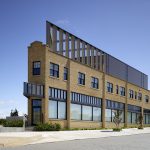Nebraska State Capitol
LOCATION
Lincoln, Nebraska
AREA
600,000 GSF
PROJECT DESCRIPTION
Alvine Engineering has developed bid documents for the first three phases of a complete renovation of the Nebraska State Capitol HVAC systems. The high-rise Capitol is a registered historic landmark with highly ornate preservation areas including State Supreme and Appellate Courts, Governor’s office suite, and legislative chambers. The building has a base pedestal of three stories, and a high tower ending on the 15th floor below the dome.
PROJECT HIGHLIGHTS
- Extensive field work to investigate mechanical and electrical routing through this building was executed by the team ahead of and during design work. Close consultation with the Capitol architect helped direct the routing and secured approval for the historic and aesthetic requirements.
- New Variable Refrigerant Flow (VRF) system will serve over half of the building. The VRF consists of floor-set console fan coil units, (FCUs), and horizontal soffit-located FCUs served by geothermal wellfield connected to water cooled/heated indoor condensing units. Both heat pumps are used in the building’s HVAC heat recovery technology design.
- Careful attention during design afforded placement of many console units in existing historic cabinets below windows, and concealing horizontal FCUs in existing/expanded soffits. The piping systems serving the FCUs include insulated refrigeration and condensate, as well as power and control conduits. In the base three floors, these are kept out of sight through careful routing above historic plaster ceiling, in plaster walls, in the unfinished basement (below first floor), and attic spaces for upper base floors.
- Condenser water system is heated and cooled by a remote geothermal well field. The water cooled condensing units are strategically located out of sight in mechanical room spaces throughout the building. Condenser water piping is likewise routed out of view in wall cavities, and reclaimed shafts.
- A 510-ton heat recovery chiller produces heating and cooling water. This modular chiller can simultaneously make heating and cooling water. This highly-efficient primary equipment works best in partial load conditions which is most of the year. It will provide winter time chilled water for preservation spaces, mechanical/electrical rooms, and other spaces that cannot readily use outdoor air free cooling.
- Hydronic pumping design utilizes new technology multi-pump, variable-speed skid packages. These factory-assembled pump skids have three or more vertical turbine pumps piped together and controlled to allow the most efficient combination of pumps and operating points possible for the constantly-changing building loads. Significant energy savings are realized when compared to single pumps with variable frequency controllers.
- Air handling units with chilled water and heating water coils were provided to serve assembly spaces. Demand base ventilation control using CO2 sensors allows for energy conservation when occupancy is low or not present.
- Refurbished approximately 170 steam radiators.
- All new digital Building Control System to replace original pneumatic controls.
- Fire sprinklers installed in three base floors and finalized sprinkler installation in other unprotected areas.
- Fully replaced fire alarms. Preservation areas have aspirating smoke detection (VESDA-Very Early Smoke Detection Apparatus) fire alarm.
- Lighting scope included restoring some interior historic fixtures and replicating missing fixtures. Other lighting work was required to support the HVAC work.
Photography credit: Kessler Photography







